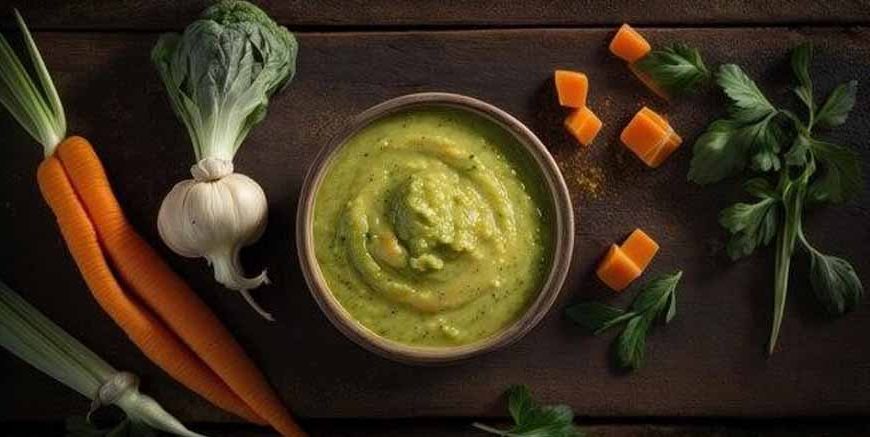Introducing new kinds of food to your little one is an important and exciting part of your child’s development stages. Vegetable purees are also useful to undertake such a process and they are packed with nutrients that are easy to digest. In this article, I will describe some easy pureeing vegetable meals and their ingredients as well as point out the most suitable vegetables for your baby’s nutrition.
Table of Contents:
- Vegetable Puree Recipes for Babies:
- How to Make Vegetable Puree for Babies:
- Best Vegetables to Puree
Vegetable Puree Recipes for Babies:
- Sweet Potato Sunshine:
- Ingredients: One moderate sweet potato and half a cup.
- Instructions: First, if you have a whole sweet potato, first rinse it, then scrape off its thick layer and after that, chop it into cubes. Steam the food and cook the dish in steam for nearly twenty minutes if required for tenderizing. Mix until it reaches a smooth consistency – you may need to add some breast milk/formula to your blend depending on the desired consistency.
- Benefits: It is commonly regarded as a food rich in Vitamin A, fibres and potassium.
- Green Pea Paradise:
- Ingredients: 1 cup frozen green peas
- Instructions: Blanch for 3- 5 minutes in steam. Puree till the consistency is thick but spreadable; adding water teaspoonful by teaspoonful if necessary.
- Benefits: Sources rich in vitamin C, fibre and proteins.
- Carrot Delight:
- Ingredients: 2 medium carrots
- Instructions: Wash and then remove the outer layer of the skin of carrots followed by slicing into desired sizes for cooking. Boil in steam for 10-12 minutes or till they become soft. Mash until soft, with the help of breast milk or water to thin down to a gruel like consistency.
- Benefits: Rich in beta-carotene as well as vitamin A.
- Broccoli Boost:
- Ingredients: 1 cup of broccoli
- Instructions: Boil broccoli in steam for about 5-7 minutes. Blend until you get a smooth paste; use water or breast milk if necessary.
- Benefits: These are foods rich in Vitamin C, fibre and calcium.
Ensure that you add one vegetable at a time and wait for maybe three days before adding the next one, to check the outcomes of allergy.
How to Make Vegetable Puree for Babies:
Making quality vegetable purees for your baby does not take much effort as most parents presume it to be. Follow these steps to ensure safe and delicious meals for your little one:
- Choose Fresh Vegetables:
- Wash Thoroughly:
- Peel and Chop:
- Puree Smoothly:
- Strain if Needed:
- Cool and Store:
- Thaw Safely:
Choose well mature vegetables. Ecological options should be used as the use of pesticides is disadvantageous for human health.
Wash vegetables thoroughly to wash off any form of dirt or any other extraneous matter that might be present.
If needed, do away with skin and seeds. Vegetables should be chopped into fine pieces and of the same size in order to cook evenly.
For a finer texture, blend the mixture in a blender, food processor or with an immersion blender, till smooth. To reach the right consistency add small amounts of water, breast milk, or formula.
If the baby is younger, or if, for example, the desired consistency is thicker, the new born puree should be passed through a fine mesh strainer.
Allow the puree to cool to room temperature and then serve the same. It’s best stored in an airtight container and kept in the refrigerator for up to 2 days or freeze in ice cube trays in the freezer for usage later.
For frozen purees, it should be stored in the refrigerator and allowed to melt for a day or heated in the microwave until the mixture is heated evenly.
As the baby advances in age and has grown used to taking solids it is possible to introduce thicker textures and different combinations of vegetables.
Best Vegetables to Puree:
When the time comes to introduce the first foods it is useful to select vegetables and fruits that are packed with nutrients and easy to break down. Here are some of the best vegetables to puree for your baby:
- Carrots:
- Peas:
- Butternut Squash:
- Broccoli:
- Spinach:
- Zucchini:
- Cauliflower:
- Pumpkin:
- Green Beans:
Mostly rich in Vitamin A and several antioxidants. They are mild and sweet in taste and that is why most babies tend to like them.
Filled with vitamin A & C, Iron & Protein. Due to their size, they are easily blended to smooth puree without having to pass through a sieve or filter.
Provides vitamin ‘A’, ‘C’, fibre and potassium. When mashed it is quite creamy and is usually enjoyed by babies.
It contains vitamin C and K, folate, and fibre content. overlook this factor since it has a relatively influenced taste when it is introduced early on this can help to build up the children a variety of tastefully.
High in iron, Calcium and vitamin-A & C compelling eaten with less nutritional vegetables.
Made of vitamin C, B6 and manganese. It has a bland taste which makes it easy to me combined with other vegetables.
Contains vitamin C, folic acid, and fibre. Because of its mild taste, one can blend it with other purees since its mild taste would not overpower the other blends.
rich in vitamin A and contains fibre. Its natural sweet taste and soft and smooth nature when mashed makes it be preferred by most baby’s foods.
The primary nutrients that should be included in a serving to help meet the consumers’ nutritional needs are vitamins A and C, fibre, and iron. Por it is a mild vegetable they are suitable for first timers in the kitchen.
When giving these vegetables to your baby make sure to consider the baby’s choices and allergic reactions. This is the reason that it takes many attempts (sometimes up to 15-20) to accept a particular food, especially a vegetable by the baby.
Feeding your baby a number of different vegetables means that they will get adequate nutrients that are vital in their development. It also enables right food choices that may also be of help in the long-run practices of finding a healthy diet plan.
Therefore, preparing vegetable purees for your baby as mentioned in this article should be considered a fun and fulfilling way to nourish your baby and introduce them to the taste of the world. By paying attention to some planning and selecting suitable vegetables, you can prepare tasty and healthy dishes for your baby and help him develop proper eating habits. Always pay a visit to your paediatrician prior to feeding your baby with solids and ensure that you introduce new foods in portions and closely monitor your child for any allergy or intolerance symptoms.
For more such interesting blogs, Visit EuroKids
















